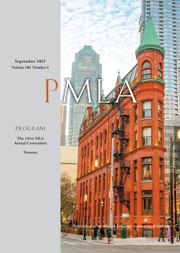No CrossRef data available.
Article contents
Reading, Writing, and History Making
Published online by Cambridge University Press: 01 September 2025
Abstract
An abstract is not available for this content so a preview has been provided. Please use the Get access link above for information on how to access this content.
Information
- Type
- Theories and Methodologies
- Information
- Copyright
- © 2025 The Author(s). Published by Cambridge University Press on behalf of Modern Language Association of America
References
Works Cited
Adorno, Theodor W. Prisms. Translated by Shierry Weber Nicholsen and Samuel Weber, MIT Press, 1990.Google Scholar
Agamben, Giorgio. State of Exception. Translated by Kevin Attell, U of Chicago P, 2005.CrossRefGoogle Scholar
Althusser, Louis. “From Capital to Marx’s Philosophy.” Reading Capital, by Althusser et al., translated by Ben Brewster and David Fernbach, Verso, 2015, pp. 9–72.Google Scholar
Benjamin, Walter. The Arcades Project. Translated by Howard Eiland and Kevin McLaughlin, Belknap Press, 1999.Google Scholar
Brecht, Bertolt. “Against Georg Lukács.” Aesthetics and Politics, by Ernst Bloch et al., edited and translated by Taylor, Ronald, Verso, 1977, pp. 68–85.Google Scholar
McCole, John. Walter Benjamin and the Antinomies of Tradition. Cornell UP, 1993.CrossRefGoogle Scholar

